It all started with a small jar and a big gesture. My friend Wendy handed me her homemade tallow balm, and I was like, “Oh, that is swell, thanks!” What I should’ve said was, “Wendy, you glorious skincare genius, how do I repay you for this potion of health and beauty?!”
Because let me tell you … I slathered that tallow balm on my face that very night and haven’t looked back since. My skin whispered, “Where have you been all my life?”… and has been glowing like a well-lit farmhouse.
Got questions about tallow balm? Of course you do (I did too!). I’m going to tackle all the burning questions you might (or might not) have, and then I’ll walk you through exactly how to make it step-by-step … like we’re in a cozy kitchen together, except I can’t hand you the spatula.
In case you decide to make tallow balm, I whipped up some FREE printable labels just for you. Go ahead, dress up your jars! Click here to get a download that you can print at home.
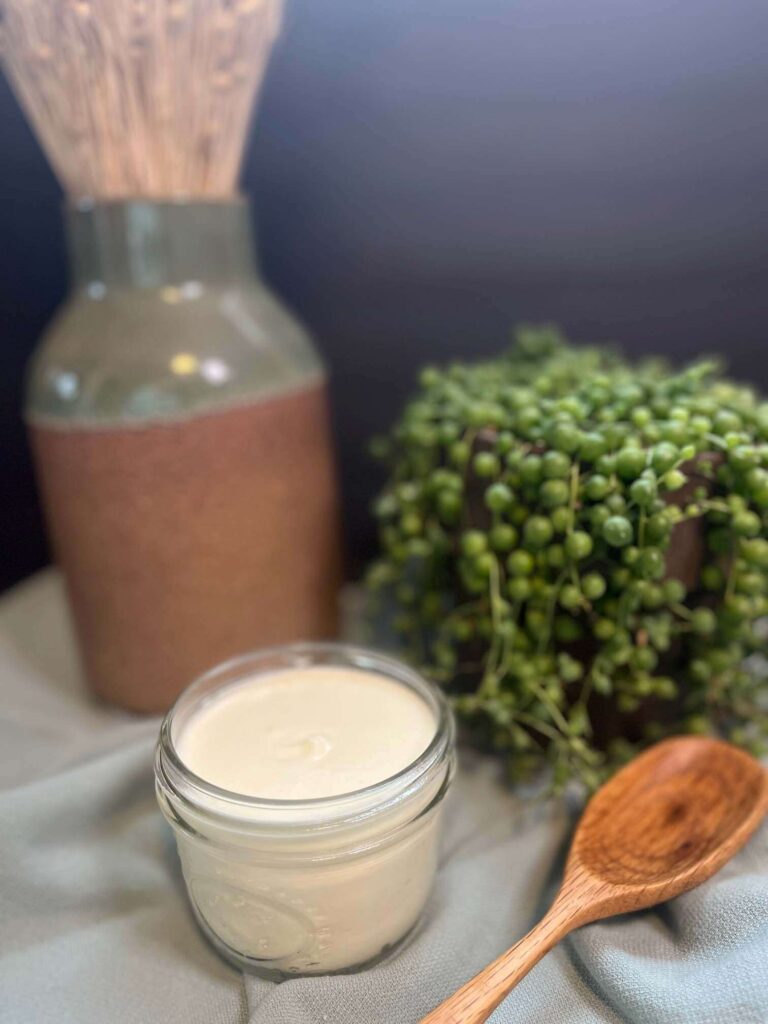
Curious About Tallow Balm? I Was, Too.
Naturally, I did what any curious person would do: fired up Google while snuggled under a blanket and eating chocolate chips straight from the bag.
“Wait, this stuff is legit?”
Another article later… “Oh dang, it’s REALLY legit.”
And now after reading more articles than I care to admit … I’m fully obsessed. There’s no going back to store-bought lotion with mystery ingredients and names I can’t pronounce.
Don’t we all find ourselves on the hunt for the next miracle wrinkle eraser or dewy-skin secret. But what if the answer isn’t in a lab… but in your grandma’s pantry? Enter: tallow balm.
Wait, What Is Tallow?
Brace yourself: it’s rendered animal fat. Yes, you heard me. In this blog, we’re working with the purified fat from cows (ideally grass-fed cows who lived their best life eating salad bars in sunny fields). Tallow often comes from beef fat, but technically it can be made from other animals too.
People have used tallow for literally thousands of years. Before there were serums, night creams, or overpriced beauty elixirs … there was tallow. It’s naturally packed with vitamins, essential fatty acids, and nutrients … no marketing team needed to help sell me this stuff. Our ancestors knew what was up.
What Can You Do With Tallow?
Glad you asked. The list is wild:
- Moisturize – like a pioneer princess
- Hair conditioner – for when your ends look like straw
- Diaper rash relief – baby butts rejoice
- Soap & candle making – homesteader chic
- Cooking oil – hello, high smoke point
- Season your cast iron – like a boss
- Baking – best pie crust you will ever make
- Condition wood – cutting boards love it
- Feed animals – lucky them
- Burn it in lanterns – like it’s 1823
OK, But What Is Tallow ... Balm?
It’s basically skin food. A luxurious, nutrient-dense moisturizer that your skin knows how to absorb. It’s nearly bioidentical to our own skin’s oils … which is science-speak for: your skin loves it and knows how to absorb it.
You can put it anywhere (head to toe):
- Dry hands? Yep.
- Red, puffy eyes? Go for it.
- Winter face flakiness? Slather it on.
- Sun-burnt shoulders? Yup.
- Chapped lips? Tallow to the rescue.
- Acne? It’s likely to help.
- Wrinkles? Balm it, baby.
- Skin irritation? Tallow wants to help.
- Scrape or scratch? Nurse Tallow is reporting for duty.
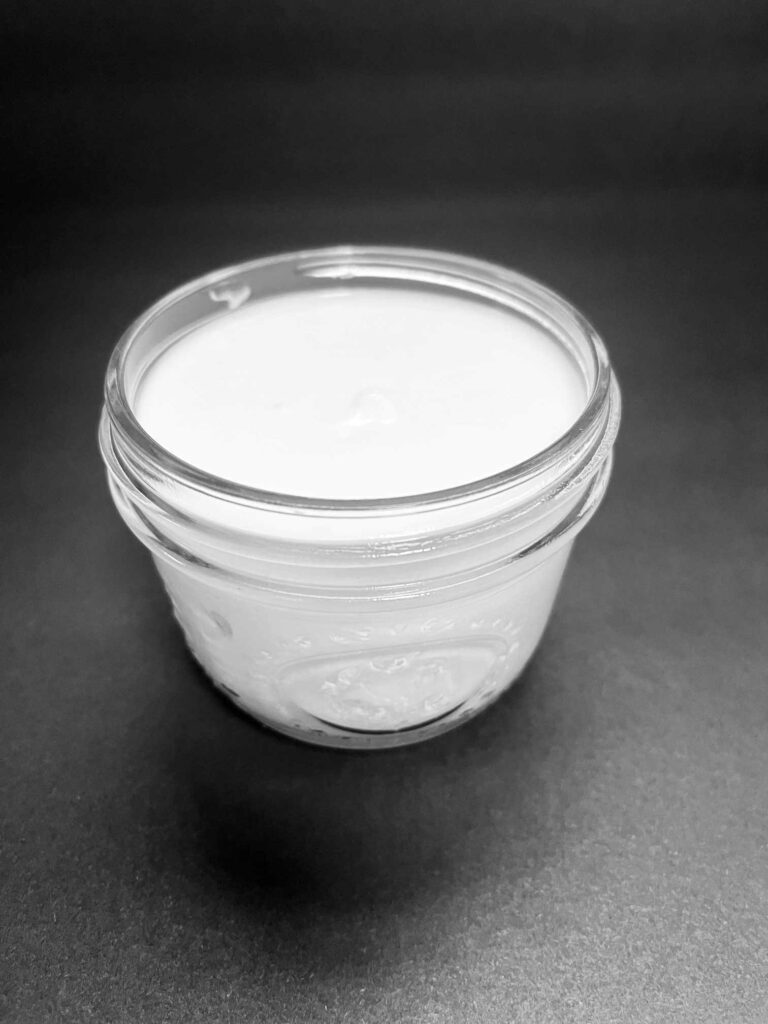
Why Is Tallow Balm So Magical?
The big unveil ….
- Packed with vitamins – A, D, E, K, B12
- Vitamin A helps reduce wrinkles and dark spots.
- Vitamin D fights off free radicals from pollution.
- Vitamin E has been known to kick warts to the curb.
- Vitamin K is eager to heal wounds.
- Vitamin B12 provides essential nutrients for collagen production.
- Boosts elasticity – Keeps your skin bouncy, like a happy trampoline.
- Fights inflammation – Say goodbye to redness and irritation.
- Supports collagen production – Thanks to all those skin-loving vitamins and minerals.
- Lasts all day – It’s not water-based like most lotions that ghost your skin by lunch.
- It’s similar to your skin’s natural oils, so it really sinks in and stays put (aging skin loves this).
- Naturally anti-bacterial – Random fun fact: In the olden days, tallow was used for things like ringworm.
- Anti-microbial – Helps keep those pesky pimples away.
- Might help eczema – it’s worth a try.
- No chemicals, no junk – Just natural, ancient goodness.
- Proven for centuries – If it was good enough for grandma’s grandma, it’s good enough for me.
(disclaimer: I’m not a doctor, but I do have a mirror … and my skin is loving this stuff.)
If you’re ready to have your socks knocked off by another healthy homemade miracle, check out my blog about fresh ground flour. Yep, you can actually make your own flour at home, and it’s wildly good for you (and ridiculously tasty, too).
What About The Smell?
Ah, yes, the slight beefy undertone. Think “savory spa,” not “grill party.” You can mask it with a few drops of essential oils for a little extra zhuzh. It’s your call. Either way, you made it yourself, which means no mystery ingredients or weird chemicals … just the good stuff.
Bonus: Essential oils don’t just smell nice … they bring their own lineup of skin-loving benefits. More on that below…
How Long Does Tallow Balm Last?
Up to a year at room temp. Longer in the fridge (if you made a huge batch of it … this is a nice way to store the extra).
Zero preservatives needed because nature knows how to do things right.
Here’s a little preview of the FREE tallow balm labels I made for you. Click here to grab yours and label your tallow balm in style.
Step-By-Step: How To Make Tallow Balm
How To Render Beef Fat (aka Make Tallow):
Quick overview: First, you get yourself some beef fat. Then you melt it. Then you strain out the weird floaty bits. Boom … now it’s tallow. You can totally DIY this with raw beef fat or skip straight to buying pre-made tallow. No judgment either way … this is a choose-your-own-adventure kind of balm.
You can skip ahead to the “Add Oil(s) to Tallow Balm” section if you’ve already scored good tallow (lucky you!). Maybe you snagged it from your local butcher (high five!) or maybe you ordered it online.
Don’t feel like rendering fat yourself? Here are two options to buy lovely tallow.
- This is a bigger jar.
- This is a smaller jar.
Both of them are 100% grass-fed and ready for balm magic.
Step-by-Step: Rendering Beef Fat
- Get the Fat: Look for grass-fed beef fat. Your best bet for finding quality beef fat? Ask a local farmer. You can ask all the good questions, and they’ll know exactly how their cows were raised. I love supporting my local farmers … and I’m pretty sure they love that, too. If you are in the Pittsburgh area … I highly recommend Lutz Farm! Or skip the DIY beef fat rendering and buy pre-made tallow (already rendered and purified). If you go this route … skip to Step 4.
- Chop the Fat: Cut the fat into 1” chunks (or grind it if you want to speed things up). You’ll probably see little bits of muscle, blood, or connective tissue attached. Trim off what you can, but don’t stress if you miss some. We’ll clean things up later with a strainer.
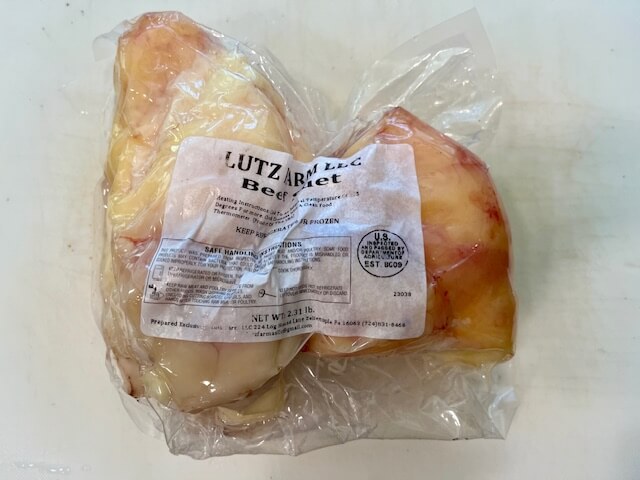
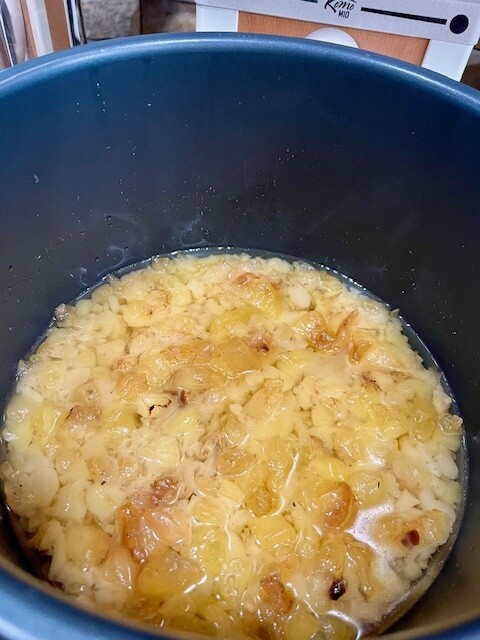
Crock Pot: Low and Slow
3. Crock Pot:
-
- Add your chopped fat to the crock pot.
- Set it on LOW. (Don’t crank up the heat! That’s how you get the beefy smell.)
- Start with your lid on for 3 hours.
- Then take the lid OFF. The fat needs to let off some steam (literally, the moisture needs to evaporate). Feeling impatient? You can give it a whirl with an immersion blender when you take the lid off. If you’re not into the whole “eau de beef” aroma … stick the crock pot outside. Toss a bit of cheesecloth over the top so you don’t end up with bug-flavored tallow.
- Stir every hour (or you can be like me and stir once every 6 hours … oops) to make sure nothing sticks or burns. This whole thing can take several hours … sometime up to 12 hours. But hey, if life happens (soccer practice, laundry pile, spontaneous nap), it can take longer.
- Once most of the fat has turned translucent and there leftover bobbing bits … it’s done! Strain it through a fine mesh strainer (or cheesecloth). Pop it in the fridge to firm it up. Once it’s nice and solid, skim off any impurities or weird beefy goo. If it still seems like the tallow needs to be refined a little bit more … feel free to melt it down again, strain it again, fridge it and skim it.
- You have successfully made tallow = rendered down beef fat. Feel free to use this to cook your morning egg … yum!
- Some people like to render their tallow in the oven at a super low temp (around 200°F). Others brave the stovetop, but I find it a little too easy to accidentally give my tallow a hot hot bath. Crock pot = way easier.
Extra Tips for Better-Smelling Tallow Balm:
If you’re aiming for the cleanest scent possible, start with leaf fat … that’s the fat from around the kidneys. It renders down to a purer, more neutral-smelling tallow.
Another trick? The first fat to melt is usually the mildest in aroma. You can set that portion aside for your balm and save the rest for cooking (I vote for french fries) or seasoning cast iron pans. That said, full disclosure: I don’t do either of these things … and my tallow balm still comes out virtually scent-free. So don’t overthink it.
Add Oil(s) To Tallow Balm
Tallow can have a mind of its own … sometimes it is firm. Other times it is soft and dreamy.
If your tallow is on the hard side, adding oil(s) will help soften it up … think more like tallow lotion and less like rubbing a candle on your skin.
Bonus: Oils don’t just make your balm easier to spread … they bring their own skin-loving benefits to the mix! I like to reach for oils that are organic and cold-pressed whenever possible.
Here are some dreamy oils to invite to the balm party (each one brings a little something special to the mix):
- Avocado – deeply nourishing, great for dry skin
- Olive – rich in antioxidants, super gentle
- Almond – soothing, good for sensitive skin
- Calendula – healing, calming for irritation
- Jojoba – closely matches skin’s natural oils
- Rosehip – full of vitamin C, helps with scars and fine lines
- Oregano – antibacterial, a little goes a long way
- Carrot Seed – supports aging skin, rich in antioxidants
4. First, weigh your tallow (using grams makes the math easier). Melt it down so it’s nice and pourable, then add your favorite oil to it. How much? Don’t worry … see below. Give it a good stir until everything’s fully blended and smooth.
- General Rule: For very soft tallow balm (more like tallow lotion), use 17% oil based on the weight of your tallow.
- Example: If you’re using 85 grams of tallow, add about 15 grams of oil. (.17 x 85 = 14.45)
- You can use just one oil or mix in a few … just keep the overall oil percentage in mind.
- Want it softer? ➝ Add more oil (but personally I would not go above 17%)
- Want it firmer? ➝ Add less oil (or none at all)
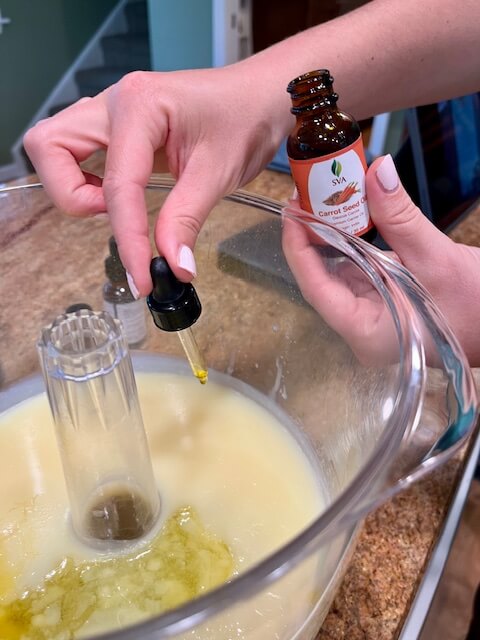
Add Essential Oils To Your Tallow Balm
First things first, you do NOT have to add essential oils. If you’re making this for a baby, someone with super sensitive skin, or just prefer your balm plain … feel free to skip essential oils. That said, tallow does have a subtle beefy undertone. If that’s not your jam, a few drops of essential oil can gently mask the scent … and bring some extra skin benefits.
Favorite essential oils to mix in … here’s a quick cheat sheet to help you pick your potion:
- Lavender – Calms skin, chills your mood, and helps with PMS and sleep
- Tea tree – Zit zapping superhero (acne’s worst nightmare)
- Chamomile – Soothing, relaxing, like a bedtime story for your face
- Frankincense – Smells expensive
- Citrus oils (lemon, orange, grapefruit) – Rich in vitamin C, boosts collagen, helps with morning sickness, and improves congestion.
- Eucalyptus – Great for oily skin, helps if you’re stuffy, and might ease joint pain
- Geranium – Helps with fluid retention + balances hormones
- Patchouli – Earthy, good for cracked or irritated skin
- Rosemary – Boosts circulation, reduces stress, may help with hair growth
5. Add essential oil to the tallow balm. Stir.
- A good rule of thumb: match the number of drops of essential oil to the number of grams of oil (I am referring to that 17% calculation above).
- Example: If you’re using 85 grams of tallow, that would be about 15 grams of oil and 15 drops of essential oil.
- If you mix multiple essential oils, just keep track of your total drop count.
Pro Tip: Not all essential oils are created equal. To keep your tallow balm clean and chemical-free, look for 100% pure essential oils … free from synthetic fragrance or fillers. I look to Plant Therapy for high-quality, trustworthy oils.
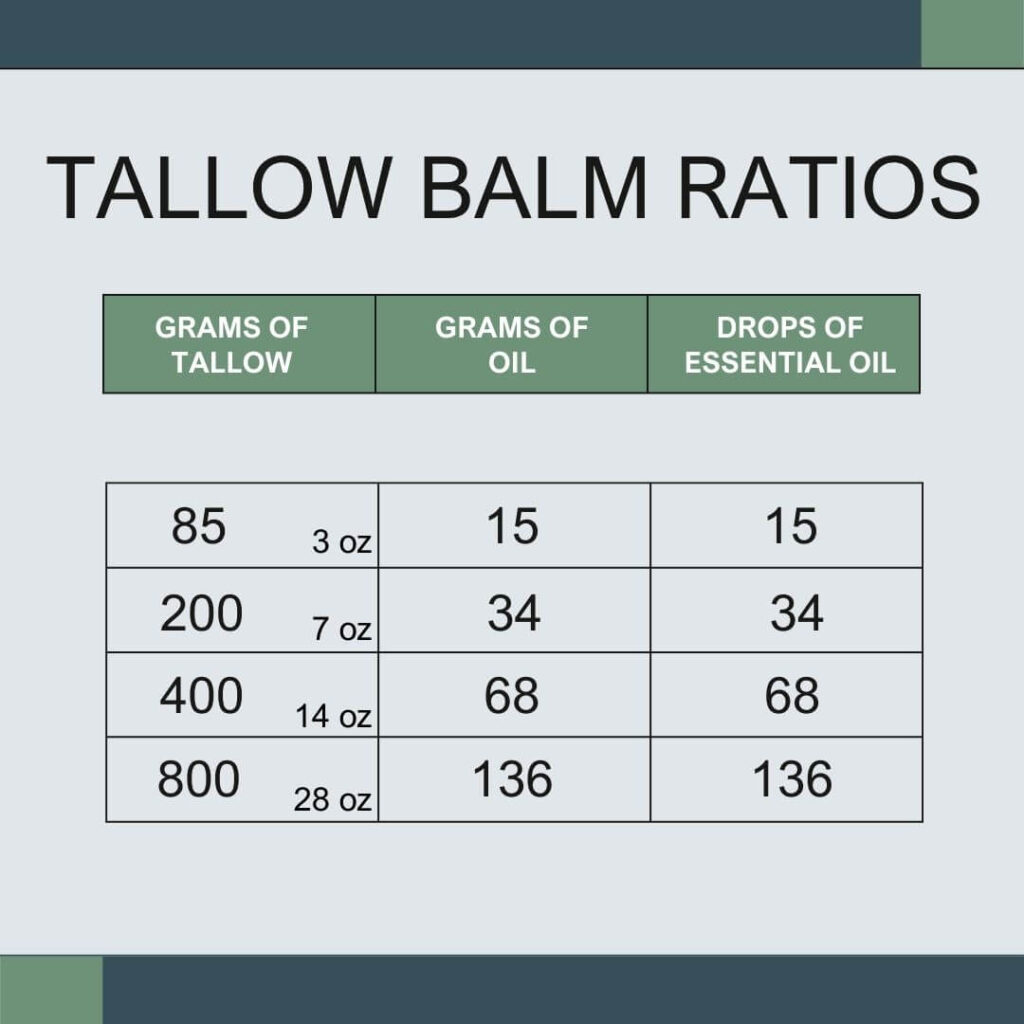
How To Whip Tallow Balm
Whipping your tallow balm makes it light, fluffy, and easier to spread … like frosting for your skin! That said, whipping is totally optional. If you’re more of a scoop-and-smear type, unwhipped works just fine too.
6. Let your balm cool and begin to set. You’re looking for it to turn white and slightly thick, but not completely hard. Think: softened butter. Want it to firm up quicker? Pop it in the freezer for a few minutes at a time. Did your tallow get too hard? No worries … just warm it gently until it softens again.
7. Use a hand mixer or stand mixer to whip your balm for a few minutes until it becomes creamy and fluffy. And that’s it!
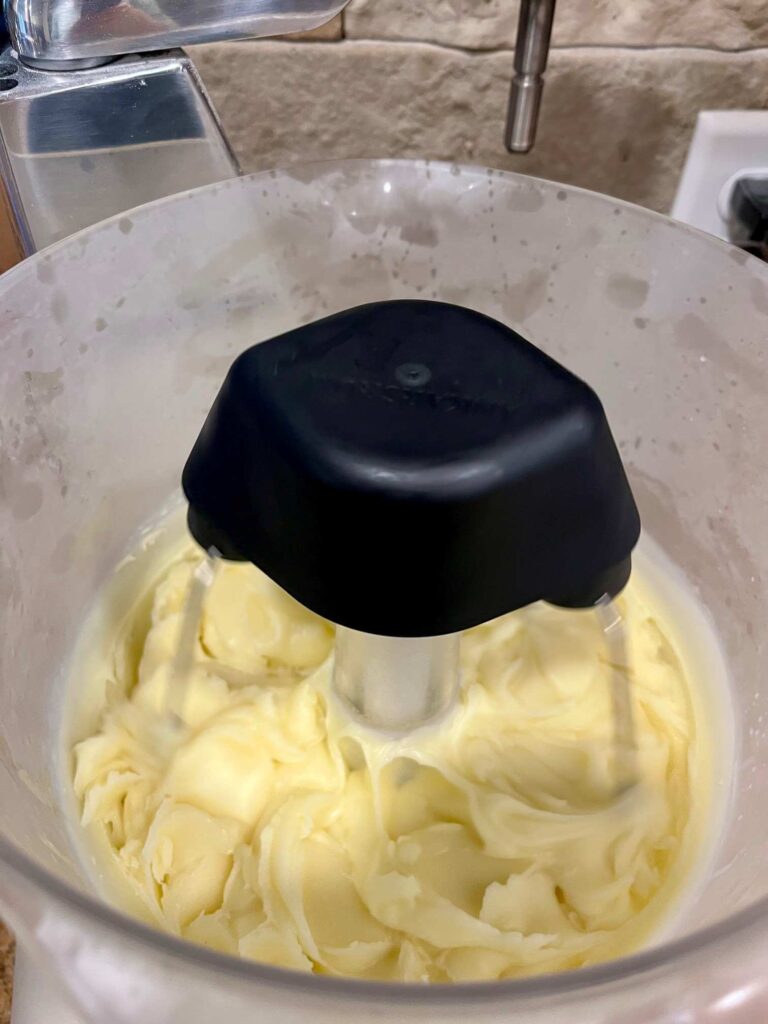
Jar Up Your Tallow Balm
Now it’s time to pick a fun container … whether you’re keeping it for yourself or spreading the love (literally).
Mason Jar Magic: I usually reach for leftover mason jars. They’re easy, practical, and already in the house. But if you’re feeling a little fancy…
The Gift-Ready Size: Many companies package tallow balm in 2 oz. jars … perfect for gifting, travel, diaper bag, glove box, gym bag, or stashing in every bathroom drawer. My friend Wendy actually gave me my very first balm in a jar like this. It looked adorable and felt special … just like the kind you’d see in a boutique.
Pro Tip: Use a pastry bag or zip-top bag with the corner snipped off to fill your jars like a skincare pro … no mess, no wasted balm, just smooth moves.
If your tallow balm is softer (more like tallow lotion), then I tend to reach for a lotion pump bottle. This funnel will help you get the tallow balm/tallow lotion into the lotion bottle.
I couldn’t resist … your beautiful balm deserves a cute label! I whipped up some free printable tallow balm labels just for you. Go ahead, dress up those jars!
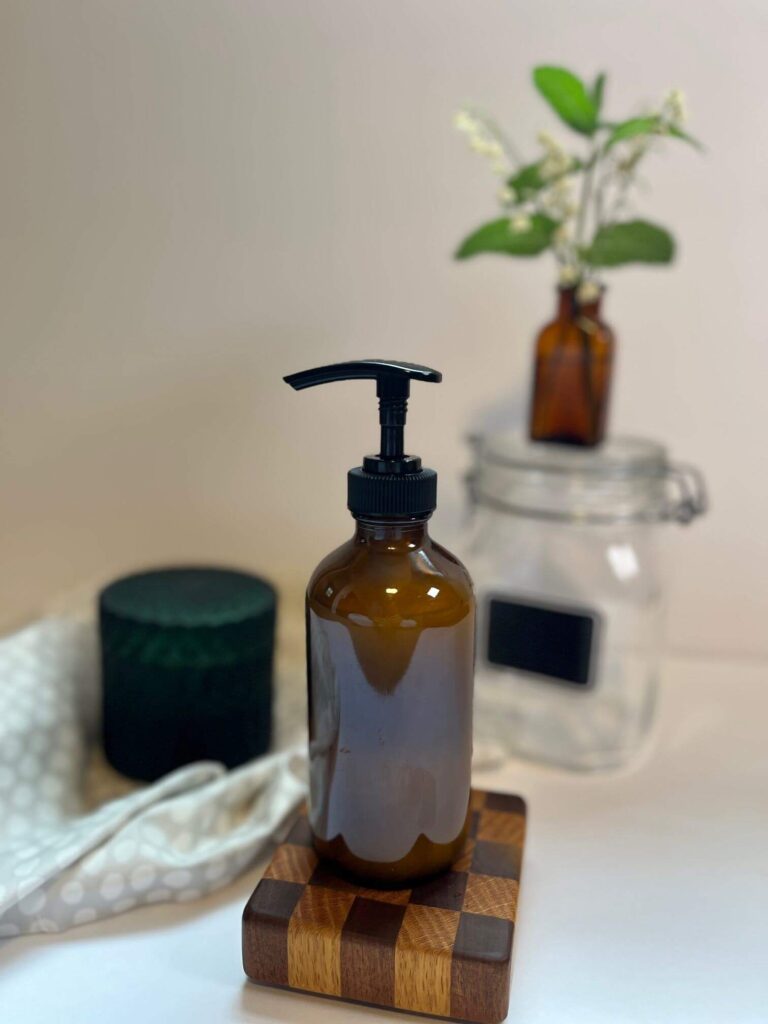
How Much Is Tallow Balm?
- Fancy Store-bought: $30-$40 for 2 oz. jars
- Homemade: About $1.10 per ounce (could have been 24 cents if I didn’t buy fancy oils for it)
Savings? Huge
Smug satisfaction? Even huger.
The breakdown of my tallow balm is:
- $5 package of beef fat from my local farmer … yielded 602 grams of tallow (21 oz)
- $0 for avocado oil (I already had it)
- $10 for calendula oil
- $8 lavender essential oil
Total Cost: $23 for 21 ounces … $1.10 per ounce!
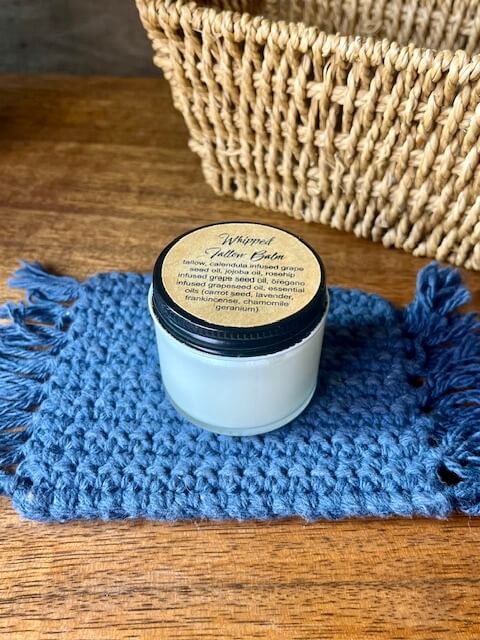
Final Thoughts
If you don’t have a magical Wendy in your life to hand you a jar of tallow balm, don’t worry. Now you can be the magical Wendy.
Make it, whip it, love it, gift it. Let your kitchen double as your apothecary. There’s something powerful about turning a humble ingredient into something beautiful and healing. You’ll know exactly what’s in it … no weird chemicals, no mystery additives … just pure, old-school nourishment. Your skin will thank you. Your wallet will thank you. Friends will ask what your secret is.
And somewhere out there, a cow is very proud of you.
Don’t forget to grab your free tallow balm labels! Click here to download and give your jars the glow-up they deserve.
Want to learn how to make tallow soap next? Let me know in the comments!
Tallow Balm
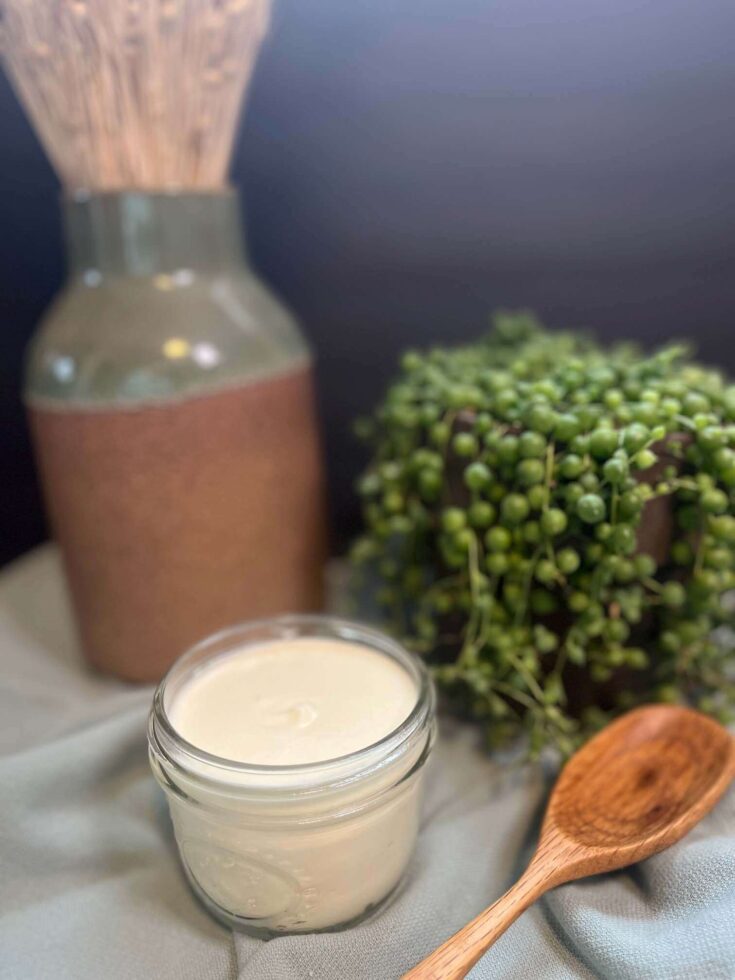
Ditch the sketchy lotions ... whip up your own nourishing, skin-loving tallow balm right at home. Tallow balm is like a multitasking superhero for your skin ... use it on dry hands, puffy eyes, winter skin freak-outs, diaper rash, sunburns, acne, wrinkles, even scrapes. It’s packed with skin-loving vitamins A, D, E, K, and B12 ... so your skin gets a serious nutrient boost with every swipe. FYI: This recipe makes a softer tallow balm ... there are easy tweaks included if you want it thicker.
Materials
- Beef Fat (preferably from a grass-fed cow)
- Oil, optional (great options: avocado, olive, calendula, jojoba, oregano, rosehip, etc.)
- Essential Oil, optional (faves: lavender, tea tree, eucalyptus, geranium, grapefruit, etc.)
Tools
- Crock Pot
- Cutting Board
- Sharp Knife
- Bowl
- Strainer or Cheesecloth
- Beater, if whipping
- Jars or Pump Bottles
Instructions
- Get The Fat: Start with beef fat (ideally from a grass-fed cow). Ask a local farmer or butcher ... they’re usually happy to help. Or, skip the DIY beef fat rendering and buy pre-made tallow (already rendered and purified). If you go this route, jump ahead to Step 4.
- Prep The Fat: Cut into 1" chunks (or grind it if you prefer). Trim off muscle, blood, or connective tissue ... but don't stress if you miss some (we will strain it).
- Render The Fat: Toss the fat into a crock pot. Set it to LOW (seriously ... resist the urge to crank it). Start with the lid on for 3 hours. Then take the lid off ... the fat needs to let off some steam (literally, the moisture needs to evaporate). Feeling impatient? You can give it a whiz with an immersion blender when you take the lid off. If you're not into the whole “eau de beef” aroma wafting through your house, stick the crock pot outside ... cover the top with some cheesecloth so you don't end up with bug-flavored tallow. Let it slowly cook for several hours, up to 12 hours. Stir occasionally. You’ll know it’s done when the fat is translucent and there are leftover floating bits. Strain through a fine mesh strainer or cheesecloth. Pop it in the fridge to firm up ... then skim off any impurities or weird beefy juice. Feel free to remelt, strain, and fridge again if you need to refine the beef fat slightly more.
- Add The Oil (optional): Weigh your tallow (using grams makes the math easier). Calculate 17% of the tallow's weight. For example: 400g (or 14 oz) of tallow = 68g of oil. If you're a math nerd (or just like pretending to be one), here's the magic formula: 0.17 × 400g = 68g of oil. Boom. Tallow math. Melt down the tallow just enough so it's pourable. Skip this oil if you want a firmer balm (move on to Step 5). Want it softer? Stir in your favorite oil ... up to 17% of the tallow’s weight. (Great Oil Options: avocado, olive, almond, calendula, jojoba, rosehip, oregano, carrot seed) Mix and match to your heart’s content.
- Add Essential Oil (optional): Match the number of drops of essential oil to the number of grams of oil you added. Example: 400g of tallow + 68g of oil + 68 drops of essential oil (yup, drops ... not grams!). Stir. (Essential Oil Faves: lavender, tea tree, chamomile, frankincense, lemon, orange, grapefruit, eucalyptus, geranium, patchouli, rosemary) Blend away!
- Let It Cool: Let your balm rest until it begins to set. You’ll see it turning white and slightly thick ... like soft butter. To make it set quicker, pop it in the freezer for a few minutes at a time.
- Whip It (optional but fun): Use a mixer to whip the balm for a few minutes until it’s creamy and fluffy.
- Jar It Up: Spoon or pipe your luscious tallow balm into a cute jar (bonus points for twine and a label.) Psst ...this label is FREE. Made it on the softer side? Store it in a pump lotion bottle. That’s it ... you made your own nourishing, old-school tallow balm!
Notes
- Use this head to toe ... from eyelids to baby cheeks.
- This nutrient-dense moisturizer is almost bioidentical to our skin's natural oils.
- Rich in vitamins: A, D, E, K and B12.
- Naturally anti-bacterial & antimicrobial.
some sentences or ideas may be from chatgpt or other AI

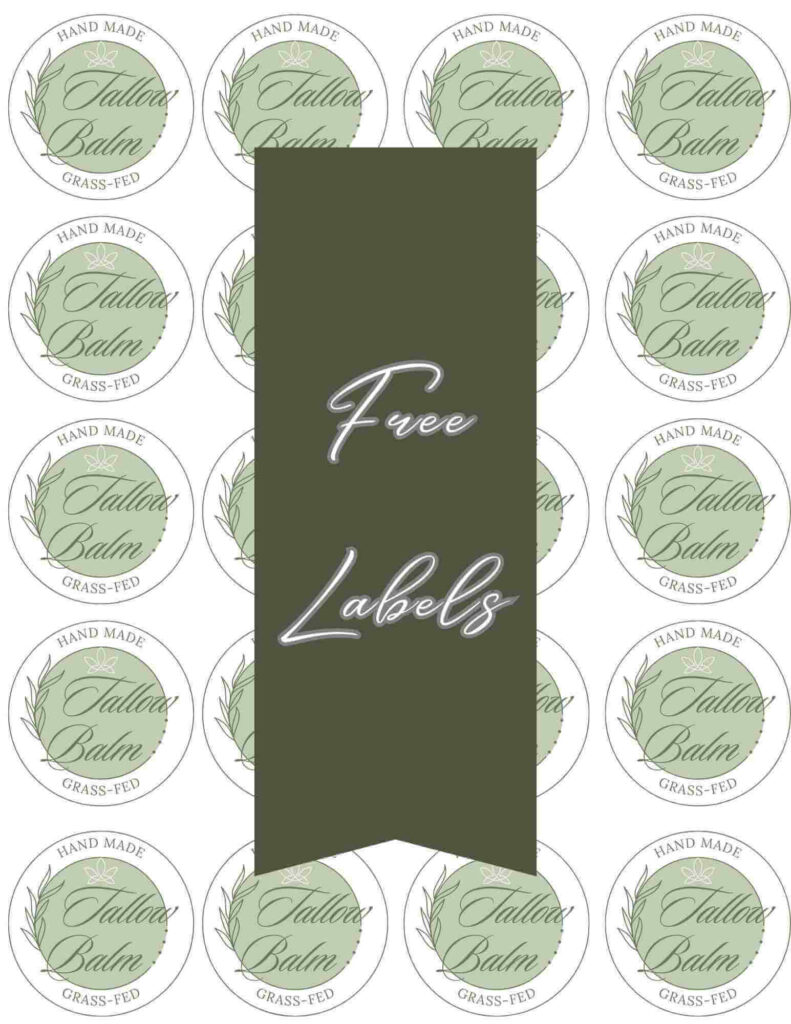







3 responses to “Tallow Balm: How to Make Your Own”
I can’t believe it’s not greasy! Game changing!!
I made this tallow balm. It actually moisturizes, unlike my lotion I’ve been using for years. Wow!
I’m so glad you’re loving it! Tallow balm is a game-changer for skin … natural, nourishing, and so soothing.